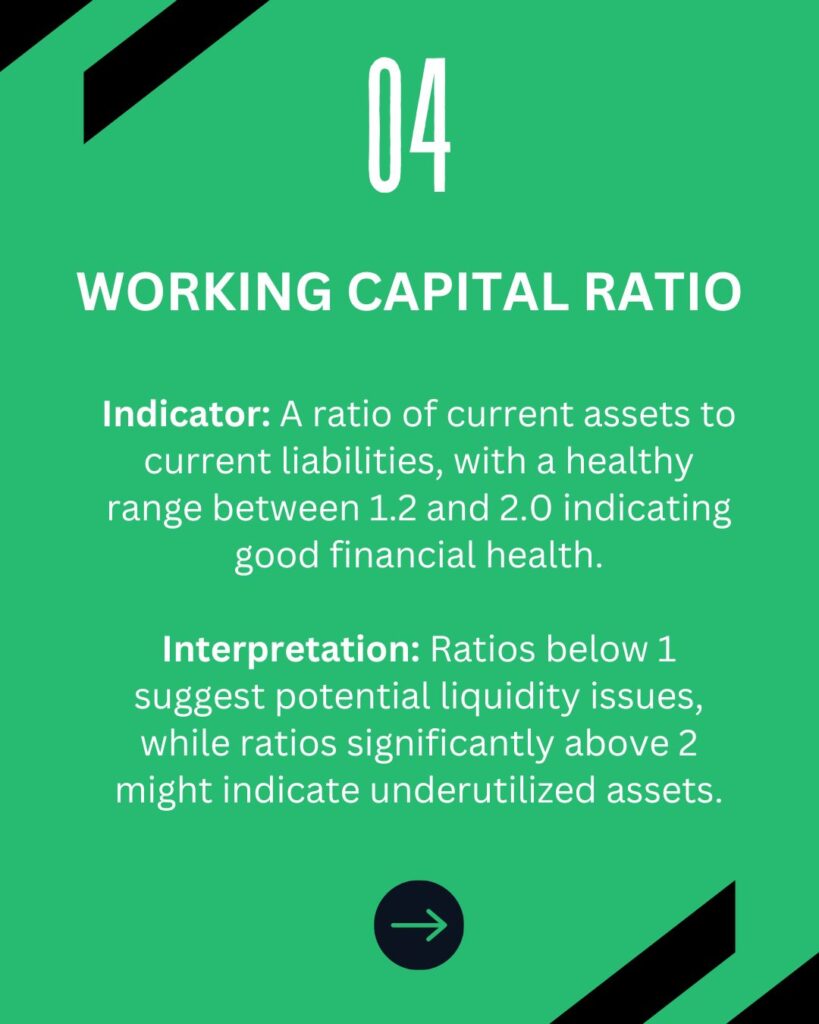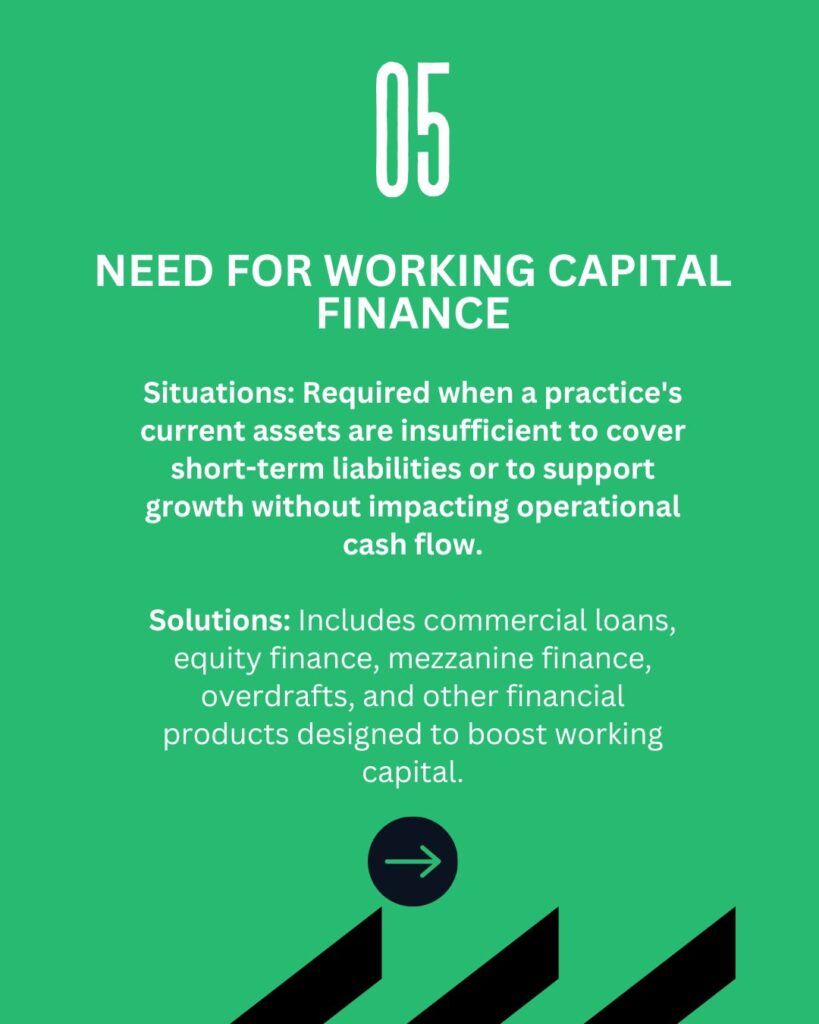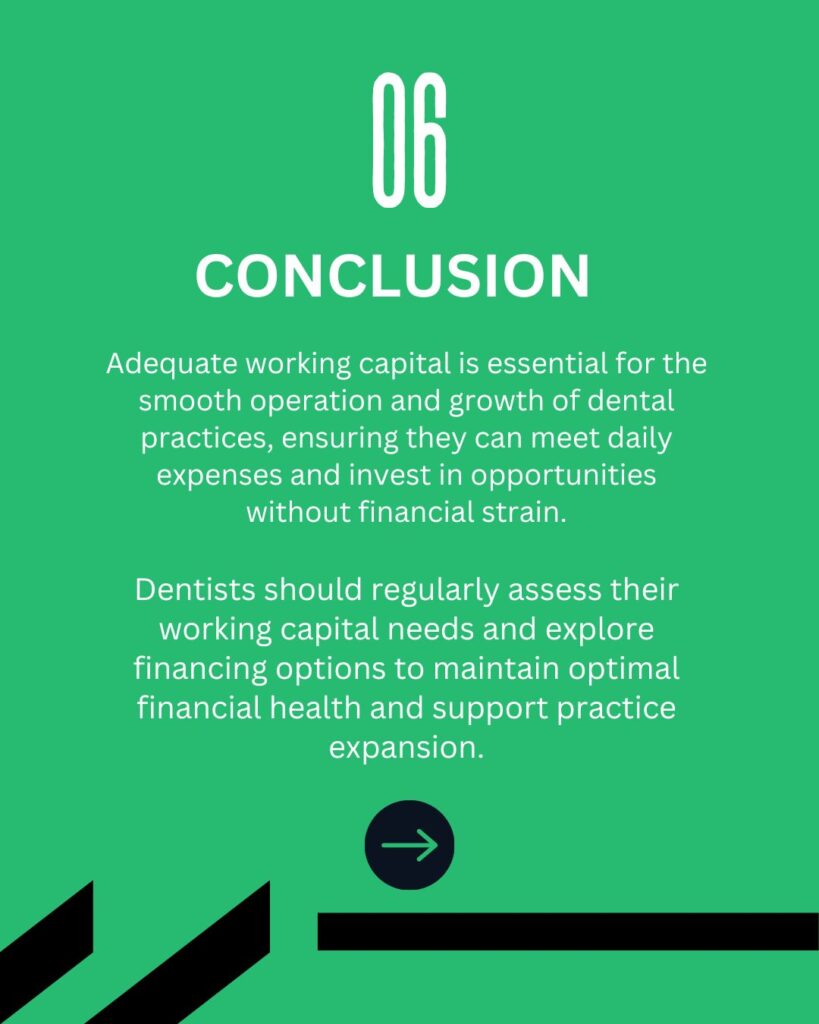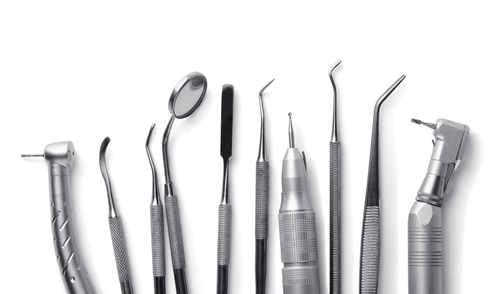What is working capital
Working capital is the amount of available money a business has at its disposal for its day-to-day operations and expenses. Working capital is not the same as the overall value of your dental practice. It is not calculated by adding up everything the business owns.
Working capital is the cash or cash equivalents your dental practice has, or can raise in a year. Working capital is calculated by subtracting the value of the business’s liabilities from its assets. It is essentially the amount of money left over once a practice pays all its standing debts.
If your dental practice is unable to meet its debts with your existing assets, you may need to apply for working capital finance.
Working capital reflects the short-term financial health of your dental practice, as well as its ability to conduct regular operations. Without adequate working capital, your practice will be unable to meet its everyday obligations.
For instance, staffing costs, rent on the premises, marketing and taxes should all be covered by the business’s available cash – its working capital. Ant given business should not need to sell off long-term assets or borrow money to meet these responsibilities. Its ability to do so is dictated by the amount of working capital.
Working capital represents the liquid cash which isn’t tied up in its long-term assets.
The most common definition is; the difference between the business’s current assets and its current liabilities.








Working capital vs cash flow
Although they are similar, related concepts and are often confused, working capital and cash flow are not quite the same thing.
Your dental practice’s cash flow is the amount of cash that moves through the business over any given period. It is the amount of money that your business can generate. Cash flow does not take into account your liabilities. Working capital, on the other hand, takes into account all your current liabilities, as well as current assets.
A working capital ratio is a representation of the financial health of your dental practice as a business overall. It is a broad picture of your business’s ability to pay off debt in the short-term. Cash flow is more concerned with the cash that can be generated. This means you could have a weak working capital but a strong cash flow. Your business is generating a lot of money, you just owe nearly as much as you make.
Therefore, even with a strong cash flow, low working capital can make it difficult to pay your debts off on time. If this is the case, you may benefit from raising working capital finance.
How to Calculate Working Capital.
Working capital is the amount left over once your dental practice has met all of its financial obligations. Working capital can be calculated with one fairly simple equation.
That equation is: current assets minus current liabilities equals working capital.

The number left over is the amount of ready cash that a business could feasibly spend without having to sell off long-term assets or borrow money from a financial institution. It can often simply be the value of the entire inventory of your dental practice added to the current bank holdings.
For example, lets say your business has £10,000 in a business bank account, a customer owes £1,000 and the business’s inventory totals £10,000. Your business has current assets totalling £21,000.
Let us also assume that the business owes £15,000 in total, spread across suppliers, debts and tax bills.
Once the business has paid off its £15,000 current liabilities from its £21,000 in current assets, there is £6,000 left over as working capital. Although the business could raise more money by selling off more long-term assets, this £6,000 is the amount it can liquidise within a 12 month period. Therefore, the entire dental practice has a working capital worth £6,000.
Current Assets
Current Assets vs Fixed or Long-term Assets
Current assets are not to be confused with the long-term assets of a business. Long-term assets are the assets that your dental practice will expect to keep for longer than 12 months, which could include a lot of necessary dental equipment. They are essential parts of the business that cannot just be sold off to pay the tax bill. They also include assets that cannot be sold off for liquid cash in a year.
They are sometimes known as fixed assets.
Although a piece of heavy machinery or a company car is an asset to the business, it is not included as a current asset in the working capital calculation as it cannot be quickly sold off for cash. It would also disrupt the day-to-day business operations to do so.
Long term assets include items such as land & property, machinery & vehicles and intangible, soft assets such as copyrights and patents. Inventory will usually be included as a current asset, since it can often be expected to be sold in 12 months. However, heavier pieces of inventory may not be included and will have to be judged individually.
Current assets, on the other hand, are the assets which can be, or will be expected to be, sold off or otherwise liquidised within a 12 month period.
Examples of current assets include:
Cash and bank balance
Most businesses have some form of account with a bank or similar financial institution. Most also have some form of ready cash available. This could range from a small petty-cash stash in the office to a locked safe containing thousands of pounds. These are immediate, liquid cash which can be instantly used to fund business operations.
Inventory
Certain pieces of inventory are often considered current assets. Whether inventory items will be listed as a current asset or not depends on whether it can be sold off for liquid cash within a 12 month period (or before the end of the business cycle).
For instance, a warehouse full of food can be reasonably expected to be sold within a 12 month period. Therefore, it is a current asset, since within a year you know that your business will exchange those foodstuffs for liquid cash.
However, the heavy machinery that the business used to process or harvest that food may not be expected to be sold off within that same 12 month period. Therefore, it would usually not be included as a current asset. Likewise, the property your business owns may be its most valuable long-term asset. However, you are not going to sell it off to pay a quick bill. Therefore, it is not considered a current asset.

Contact us to find out more
Accounts Receivable
Accounts receivable are the bills owed to your business (but not yet paid) for goods or services already rendered. For example, if you sell a customer a car and the deal includes them not having to pay any money for the first 6 months, you have an account receivable. This can often include long term dental services that can be billed at the end of a treatment.
Although you do not have the money in your business’s bank account at the moment, it is owed to your business. You may not be able to call it in earlier, but you know that it will be in your bank account in 6 months – unless the customer defaults!
As long as accounts receivable are expected to be paid within a 12 month period, they are considered current assets.
Marketable securities.
Your dental business’s marketable securities are the debts and securities that you can expect to redeem or trade in with a 12 month period. If they are not redeemable within that 12 month period they are considered a fixed asset. They are financial instruments which can be easily liquidated into their market value in cash in one year..
Examples of marketable securities include things such as Government bonds and treasury bills, certificates of deposit and stock.
Prepaid expenses
Prepaid expenses are the expenses paid by the business before a good is received or a service is rendered. For example, leasing a piece of equipment or office space, or even insurance payments are considered prepaid expenses.
Prepaid expenses are considered current assets if they are expected to be completed within 12 months. If your business leases a piece of equipment for less than 12 months, it is considered a current asset. If it is leased for longer than 12 months, it will be considered a fixed asset.
Since the expense has already been paid, this means other working capital can be used for business operations. If you prepay £12,000 for 12 months rent at £1,000 a month, that £1,000 still shows up on the balance sheet. However, since you have already paid it, you essentially have £1,000 extra as working capital.
Current Liabilities
Current liabilities are the financial obligations a business has that it is expected to pay back within a 12 month period. These are the debts that a business needs to pay back within a year, in other words, the business expenses. Debts that you are not expected to repay within that year are not considered current liabilities, they are known as long-term liabilities.
Current liabilities are normally paid off using the current assets. Most businesses will have several current liabilities owed at the same time to suppliers and creditors. Most of the everyday costs of operating a business are paid monthly or as needed, and are therefore considered current liabilities. For instance, utility payments for the offices or warehouses, materials and supplies or business loan repayments.
Examples of Current Liabilities
Accounts payable
Accounts payable are the debts owed by your business for goods or services that have been already received or rendered. They are the outstanding invoices to your suppliers and vendors that are due to be repaid within 12 months.
Any debt that is due within that period is considered a current liability. Debts that are not expected to be repaid in a year will not be listed on your balance sheet as current liabilities.
Accounts payable will cover debts such as supplier invoices, utility bills and invoices from external companies such as legal and marketing services.
Short term debt
Short-term debt, otherwise known as operating debt, are the short-term financial obligations your business has. Operating debt usually takes the form of short-term loans from a high street bank or another financial lender. They can also be issued as commercial paper.
These debts are normally taken out to cover short-term operating costs of the business, such as supplies, bills and invoices. If the debt is expected to be paid within 12 months, it will be considered a current liability.
If you have debt with a loan term of 10 years, that is considered a long-term debt. However, in that final year, it will appear on the balance sheet as a current liability since it is due within 12 months.
Dividends payable
If your dental practice has shareholders who are paid dividends, they may be included are current liabilities on your balance sheet. Once it has been decided that a certain amount should be paid in dividends to the shareholders, they are considered current liabilities until they are paid.
Accrued expenses
Accrued expenses are the expenses which the business knows will have to be paid within a year. They are listed as expenses on the balance sheet but have not yet been paid. Therefore, they are considered current liabilities.
Accrued expenses can cover a range of different payments. For instance, accrued expenses could cover interest payments, including interest for long-term debts, payroll and tax.
Working capital ratio
It is common for a dental business’s working capital to be expressed as a ratio, the working capital ratio. This is a numerical expression of the financial health of the business. A healthy working capital ratio would be between 1.2 and 2.0.
Working capital ratios are calculated by dividing your business’s current assets by its current liabilities. For example, let’s say your business has current assets totalling £750,000 and your current liabilities come to £500,000. We divide the two and get a working capital ratio of 1.5.
If the same business’s liabilities raise to £650,000, the working capital ratio changes to about 1.15. This business is approaching negative working capital, i.e. having more in liabilities than it does in assets. This business may need to apply for working capital finance to pay its debts.
However, if the liabilities fall to £250,000, the working capital ratio is 3. Although it may appear at first sight that the higher the ratio the better, this is not necessarily the case. With £500,000 more in assets than it does in liabilities, this business has an excess of working capital that it should be using to grow the business.

What can cause changes to working capital
A dental practice’s working capital is affected by a wide range of different factors. You can expect your working capital number or ratio to change almost daily.
The most obvious are times when you makes large short-term purchases or sales for your practice. Purchasing new inventory or office supplies will cause your working capital to decrease by increasing the current liabilities. Likewise, selling off property or inventory will increase your working capital ratio by increasing current assets.
The ratio will also change due to long-term assets and liabilities changing in status. For example, a 25 year mortgage is a long-term asset until the 24th year. In that final year the remainder is expected to be paid within a 12 month period, therefore making it a current liability.
There are also instances where customers default on their debts and you may not be able to bring in the accounts receivable that you had planned on. Changes to markets may also mean that your inventory is subsequently valued at less than you purchased it for. This reduces its value and creates a discrepancy with the balance sheet.
If your practice is struggling to pay its debts, whether this be due to an increase in the liabilities or a decrease in the asserts, you may need working capital finance.
When you will need Working Capital Finance
Working capital finance loans are those loans taken out by any business including dental practices to cover short-term expenses. They are not taken out to cover purchases of long-term assets or investments such as property. Businesses apply for working capital finance loans when their current assets and cash flow cannot cover necessary short-term payments.
For instance, a business may take out a short-term working capital loan to cover expenses such as payroll, tax payments, interest payments or inventory purchases.
In a perfect world, all businesses and dental practices would use their own liquid cash or cash equivalents to cover these expenses. However, if a business has a weak cash flow or insufficient working capital in the form of current assets, they may choose to borrow the money to make payments in the form of working capital finance.
Alternatively, businesses may not wish to relinquish any of their current assets to pay liabilities and may prefer to borrow money to do so.
Businesses that experience a high degree of seasonality in their operations, for instance hospitality companies or businesses based in a tourist-centric region can often benefit from working capital finance. If they are unable to cover expenses in their off-season, a working capital loan can allow the business to make necessary purchases.
Dental practices looking to grow quickly, or in the process of doing so, may also apply for working capital finance loans.
Contact us to find out more
Options for Working Capital Finance Loans
The term working capital loan is essentially an umbrella term for any short-term business support loan used to cover business expenses like payroll and tax.
As such, there are several different types of loans and methods of financing that can raise the working capital required to make important purchases and payments.
Options for raising working capital finance include:
Commercial Loans
Commercial loans are perhaps the most common form of working capital finance. These are simply commercial loans that have been received from a financial lender such as a high street bank.
Any loan that is intended to be used to make short-term purchases, as opposed to long-term investments, can be considered a working capital finance loan.
Equity Finance
Many dental practices choose to use equity financing to fund short-term payments. Equity finance is when a business sells part ownership of the business itself in the form of shares in exchange for capital.
Although you can raise a lot of quick capital with equity financing, you will lose at least some control over the operations and strategy of the business.

Equity finance can be raised in a number of ways. For instance, venture capital investors or business angels will purchase shares in exchange for capital. Similarly, you can float the business publically and offer shares out to the wider public.
Mezzanine Finance
Mezzanine is a hybrid form of financing that acts as a middle ground between traditional commercial loans and equity finance. Mezzanine finance takes the form of a normal commercial loan that is guaranteed with business equity.
In other words, you receive a loan in return for regular payments with interest. If you are unable to meet these payments, the lender has the right to receive payment in the form of equity. You will give up part ownership of your business to the lender if you are unable to repay in full.
Overdrafts
It can be possible to obtain a business overdraft from certain banks and sources of alternative lending.
Overdrafts of your dental practice are, in effect, a form of unsecured loan. However, being unsecured does limit how much you can borrow. You will need to demonstrate a strong credit history and ability to repay loans on time to be able to secure meaningful funding in this way.
However, should you be able to do so, overdrafts can be a good way to quickly raise short-term capital.
Revolving credit facilities
Revolving credit facilities can be another way to raise short-term working capital finance for business growth and necessary payments and are similar to overdrafts. A revolving credit is essentially a line of credit offered to businesses from banks and other financial lenders.
A certain limit of credit will be agreed upon between the business and the lender. The business in question, i.e. your dental practice can proceed to then borrow anything up to this limit at any time. Interest is charged on the outstanding debt until it is paid.
Revolving credit facilities are ongoing agreements between creditor and debtor, they are not a fixed loan amount like a traditional commercial loan.
Revolving credit facilities can be a great way to regularly and reliably raise short-term capital.
Invoice finance
Invoice financing is a way for dental businesses to free up working capital that is currently tied up as a current asset in the form of outstanding invoices.
When businesses sell to customers, this is often done so on credit. This is especially true for larger businesses who do not expect customers to pay immediately or for big dental treatments that are paid in instalments or after the treatment has been completed to its end. Instead, the customer is issued an invoice and they pay on or by an agreed upon date.
However, since the goods or services have already been purchased, their value is now tied up in that invoice. Until the invoice is paid, that value is absent from the business.
Invoice financing is a way to free up that working capital by selling the invoice to an invoice factoring company. These companies buy the invoice for a charged percentage. The owed business can then be paid the value of the invoice quicker than if they had waited for the customer to pay on the due date.
This frees up working capital that would otherwise be tied up as a current asset.
Asset Refinancing
Asset refinancing is a way for dental businesses to free up working capital that is currently tied up in their long-term assets which many dental practices usually have in spades. Through asset refinancing, your business can gain access to some of the cash value of the asset without having to sell it off.
Refinancing allows you to borrow money against equity in the asset. This means that you can borrow money against assets you do not fully own. Your loan will be valued against the value of your equity.

When you refinance an asset, you transfer ownership of it to the lender. However, you still maintain the use of it and the lender does not take it away. Once the loan has been fully repaid, full ownership of the asset is returned to you or at least your portion of equity is returned to you.
If you are unable to repay the debt, the lender takes full control of the equity you laid against the loan.
Asset refinancing can be a great way to gain access to value currently tied up in your fixed assets, whilst still keeping them in the business.
Merchant cash advances
Merchant cash advances are a relatively new method of accessing working capital finance. Merchant cash advances allow businesses to borrow money valued against their average monthly profits. The loan is then repaid as a percentage of revenue each month.
If a business makes lots of transactions using a credit card, merchant cash advances allow lenders to forward money based on the monthly credit card takings. This makes them a great option for retail businesses that have a good cash flow but not that much in the way of valuable assets.
If your business made £10,000 last month, lenders will usually agree to lend you the same amount. You usually cannot borrow more than you make in an average month as you will be less able to pay the loan.
Once the money has been advanced, the balance is paid back each month as a percentage of revenue.
Government support
In certain cases and in certain healthcare industries (including dentistry), you may be able to apply for government support to help cover working capital finance for your dental practice.
Many local councils offer financial support and advice to local businesses. It is worth contacting your local council to find out what support and signposting services they offer. You may qualify for a grant or loan directly from them. In other cases, they may direct you to external organisation who may be able to help.
The UK Government is also currently offering help with working capital finance to exporting businesses. The Export Working Capital Scheme aims to help businesses who are operating in the UK but exporting goods outside of the nation by assisting access to working capital finance.
The UK Government will guarantee up to 80% of risk to the lender to help fund pre and post shipment costs.
Click here to read our blog on How to finance a healthcare business.
Business Loans for Healthcare Businesses
We’ve been helping to fund the future of British healthcare businesses for over 20 years and our team are made up of former bankers with decades of experience in the UK’s healthcare lending sector.
You can find out more about working with Samera and the financial services we offer by booking a free consultation with one of the Samera team at a time that suits you (including evenings) or by reading more about our financial services at the links below.
For more information on raising finance for your healthcare business, including more articles, videos and webinars check out our Learning Centre here, full of articles and webinars like our How to Guide on Financing a Dental Practice.
Make sure you never miss any of our articles, webinars, videos or events by following us on Facebook, LinkedIn, YouTube and Instagram.



